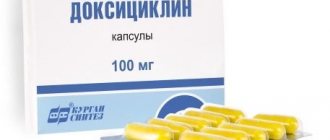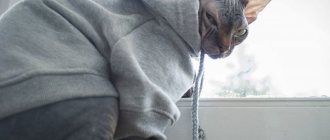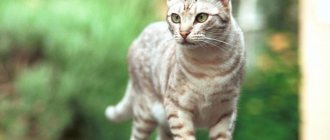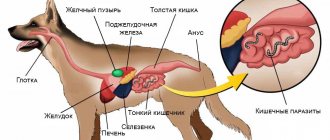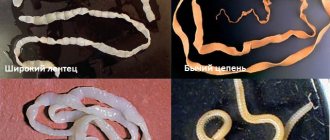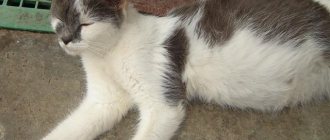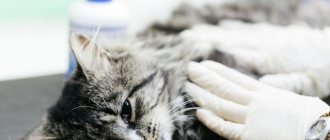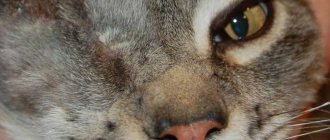The curiosity and active lifestyle of domestic cats often play a cruel joke on them, causing a foreign object to enter the gastrointestinal tract. The owner of a furry fidget must know not only the symptoms of the disease, but also what to do in such a situation, what danger a foreign object poses in the animal’s body. Often, in order to save the life of a pet, a veterinarian has to resort to surgery.
Why does a cat swallow objects?
Experienced breeders and veterinarians know that most often the penetration of foreign bodies occurs through the digestive tract. Curious cats, playing with various objects that come into their field of vision, often swallow them. Especially often, during the operation, veterinarians discover caps from valerian, parts of children's construction sets, coins, construction waste, and burst balloons.
The peak of calls regarding animals swallowing a foreign object usually occurs during the New Year holidays. Bright tinsel, small Christmas tree decorations, parts of garlands, and Christmas tree decorations attract the attention of curious cats with their shine and rustle.
Furry couch potatoes are partial to handicraft items (threads, needles, buttons, decorative elements) and fishing gear (line, hooks, spoons, wobblers, etc.).
The risk group includes small kittens and young animals. Due to natural curiosity and lack of life experience, young animals try new objects and often swallow them. Animals left to their own devices for a long time are also at risk. A bored cat tries to entertain itself by playing with foreign objects. Veterinarians also consider hair balls in a cat's stomach to be a dangerous foreign body.
We recommend reading about how to cure a cat’s runny nose and sneeze at home. You will learn about the possible causes of sneezing in cats, home treatment methods, and preventive measures. And here is more information about why a cat coughs, as if it was choking.
Is a foreign body really dangerous?
A foreign body entering the digestive tract can lead to the following health problems:
- dehydration due to vomiting and the animal’s refusal to drink water;
- pathologies of cardiac activity up to complete cardiac arrest due to penetration of a sharp object through the wall of the stomach into the pericardium;
- violation of the integrity, numerous ruptures and damage to the mucous membrane throughout the gastrointestinal tract when a foreign body moves due to peristalsis;
- ulcerative lesions of the stomach, small and large intestines;
- necrotic processes due to prolonged presence of non-sterile objects in internal organs;
- blockage, intussusception, intestinal obstruction;
- perforation of the walls of internal organs with sharp objects;
- peritonitis with a high mortality rate.
Veterinary specialists, understanding the danger of a pet swallowing an inedible object, strongly recommend that owners closely monitor their pets and have an idea of what clinical signs are typical for this situation.
Intestinal obstruction
- this is a complete or partial cessation of the movement of contents through the intestines. The most common cause is foreign body blockage. This is followed by blockage as a result of a tumor, volvulus, hernia or intussusception (penetration of one part of the intestine into another), etc.
Mechanical blockage with a foreign body reveals itself suddenly, out of the blue. How this happened a few days ago with my cat Avatar. Who is the cat Avatar and what is special about him - see, it will be interesting.
Avatar
In the afternoon, vomiting suddenly began. At first I didn’t attach any importance to this. Well, I vomited once, who doesn’t? Again. Already alarmed. And I got really worried when the cat flatly refused to eat, without even looking towards the bowl. To test, she offered an impossible delicacy - a piece of chicken. Decisive refusal. Everything is bad!
Vomiting continued at night. And the next morning we were already at the clinic. They immediately took blood for analysis and put me on a drip without talking. Why?
Symptoms in a cat
Ingestion of a foreign object does not always occur before the eyes of the owner. The discovery of the loss of one or another item in the room and the inadequate condition of the cat should cause alarm among household members and force them to take a closer look at the presence of the following symptoms in the pet:
- When an inedible object gets stuck in the esophagus, severe salivation is observed.
- When an object is localized in the pharynx, the cat coughs, wheezes, and may experience cyanosis of the tongue and loss of consciousness.
- The animal is anxious, stretches its neck, and makes frequent swallowing movements.
- Constant vomiting, belching. The duration of vomiting can last from several hours to several days, depending on the severity of the damage to the digestive canal and the location of the object.
- Complete lack of appetite, the animal refuses even its favorite treat.
- Pain in the abdomen, accumulation of gases, bloating.
- Lethargic and apathetic state, drowsiness.
- Stool retention, diarrhea, constipation.
- Reducing the amount of feces.
- With chronic obstruction, cachexia develops due to decreased appetite.
- Signs of general intoxication of the body.
Bearing in mind the danger of foreign bodies entering the gastrointestinal tract of a domestic cat, the owner should immediately take the animal to a specialized clinic.
Causes of the phenomenon
A sufficiently large volume of fluid accumulates in the stomach and small intestine, associated with blockage of the passages, which causes nausea and vomiting in the cat. In this case, dehydration of the animal’s entire body occurs and loss of vital elements: potassium and sodium. Even drinking water during an exacerbation of pathology has the opposite effect - it increases vomiting and accelerates the process of dehydration. It is from the loss of fluid and necessary elements that the vast majority of animals die.
Intestinal obstruction can be caused by:
What to do when a cat swallows an object
Veterinary experts strongly recommend that owners who discover that a cat has swallowed a foreign body not take any independent action. Lack of professional skills and knowledge will lead to even more severe consequences for the pet’s health.
For example, you should not give petroleum jelly, which can cause intussusception when a foreign body is in it. Under no circumstances should you induce vomiting if there is a suspicion that a sharp object, alkali or petroleum product has been swallowed.
The owner must ensure that the animal does not take food or water before visiting the veterinarian, provide the cat with complete rest and urgently take it to a specialized clinic.
Partial obstruction
With incomplete obstruction, part of the intestinal contents can pass through the obstruction, but with complete obstruction, not. With partial blockage, the animal can survive, while complete blockage poses a mortal danger.
Avatar
Two years ago, with the same Avatar (oh, poor cat!) we experienced partial obstruction. Avatar opened the cabinet under the kitchen sink and gutted the trash can. For more than two weeks (!) the cat was lethargic, ate a little and only soft food, there was stool, but very scanty. An X-ray with contrast did not give an accurate result (50x50 - it seems like there is an obstacle, but the contrast agent seems to pass through it). I was given intravenous drips every day. The doctors were inclined to operate.
Deciding that there was nothing to lose anyway, I literally pumped the cat up with Vaseline oil (I had done this before, but not so decisively - there was no result). And Avatar finally produced such a bunch of sausage skins that it was impossible to imagine how it all fit in a small intestine, lay there for two weeks, and the cat lived with it! But imagine my amazement when the next day another similar pile came out. Just unbelieveble! Since then, we have kept the trash can under safe lock and key.
Diagnostics in a veterinary clinic
After taking a history and physical examination, the veterinarian begins special examination methods to visualize the foreign object. The following diagnostics are used in veterinary practice:
- Survey radiography of the abdominal organs. It is carried out in two projections: direct and lateral. For a more detailed study, radiography is carried out in a vertical and horizontal position of the furry patient. The method allows you to determine the presence and location of radiopaque objects (metal needles, paper clips, etc.).
On the radiograph: a penny in the intestines of a cat
- To visualize foreign objects such as plastic, threads, a radiopaque substance is used, which is injected into the animal’s body.
- Ultrasound examination of the digestive canal and organs of the thoracic and abdominal cavity. The method allows you to detect intestinal obstruction and determine the state of intestinal motility.
- Using a fiber optic fiberscope, your pet will undergo an endoscopic examination of the esophagus and stomach in a specialized institution. The method is effective if no more than 3-4 hours have passed since the foreign body was swallowed.
Laboratory methods for examining blood and urine are of an auxiliary nature and are necessary for the differential diagnosis of intestinal obstruction due to an infectious disease, intoxication, etc.
Removal by operation
You can preserve the health, and sometimes even the life, of your beloved pet if it swallows foreign objects with the help of surgical intervention performed by an experienced veterinarian.
From the intestines
When intestinal obstruction is confirmed by radiographic and ultrasound methods, the surgeon, as a rule, decides to perform diagnostic laparoscopy. During the operation, the foreign body is removed and the intussusception is reduced. If necessary (in cases of necrosis), part of the intestine is resected.
To learn how to remove a foreign object from a cat’s intestines using enterotomy, watch this video:
From the stomach
In rare cases, it is possible to remove a foreign object from the stomach using diagnostic gastroscopy. If a foreign body is detected in the stomach of a domestic cat using endoscopic, x-ray or ultrasound examination, the surgeon usually decides to perform a gastrotomy.
Removal of threads from the stomach during gastrotomy
Having gained immediate access, the stomach is held in place using ligatures. The foreign body is removed using instruments or palpation. After suturing the mucous membrane and muscle layers, the organ is returned to its anatomical location. The operation is performed under general anesthesia.
From the esophagus
If the location of the foreign body is the esophagus, in some situations it is possible to remove it using an endoscope. If the object is large, the surgeon can perform an esophagotomy. The operation is indicated if the x-ray shows perforation of the walls of the esophagus, or the foreign body is large and has sharp edges.
Often the veterinarian resorts to the following manipulation. Using an endoscope, an object is pushed into the stomach, after which the animal undergoes a gastrotomy, followed by removal of the foreign body.
Removing a foreign body (needle and thread) using an endoscope.
After laparotomy, gastrotomy or esophagotomy, the animal is prescribed a 24-hour fasting diet. Subsequently, the operated pet receives liquid food in small portions. Weakened and dehydrated animals must undergo infusion therapy. To prevent peritonitis and postoperative complications, a course of antibacterial drugs is prescribed.
In complicated cases, the pet is left after surgery for 2-3 days in a specialized institution, using parenteral nutrition. A follow-up ultrasound examination is required after surgery.
We recommend reading about why a cat has bloody stool. You will learn about the reasons for the appearance of blood in the stool, the actions of the owners before going to the veterinary clinic, diagnosis and treatment. And here is more information about how to give an enema to a cat.
Therapeutic diet
Recovery includes proper nutrition for the cat after intestinal surgery. The animal cannot be fed for the first 24 hours after the intervention. Later, you can give liquid and soft food, food soaked in water. It is better to choose holistic food products or premium brands with the Sensitive label, as well as high-quality canned cat food, which should be crushed until smooth. If it is difficult for your pet to move, it is recommended to feed him by hand. When the animal gets stronger, they offer twisted lean meat (store-bought minced meat is not suitable), oatmeal or rice porridge in water without salt.
Prevention
Knowing about the serious consequences and threat to life when swallowing foreign objects, the owner must strictly follow the following recommendations of veterinary specialists:
- keep the room in which your furry pet lives clean;
- there should be no small items on the floor or within the reach of the animal;
- the feed must be checked for the presence of foreign impurities;
- It is unacceptable to feed a cat bones;
- Toys for your pet should be soft and large in size.
Penetration of a foreign body into the digestive canal of a pet is a dangerous phenomenon for health and life. The animal must be urgently taken to a specialized facility for special diagnostic procedures to visualize the swallowed item. As a rule, treatment comes down to surgical removal of the foreign body by laparoscopy, gastrotomy or esophagotomy, depending on its location.
Similar articles
- Foreign body.
This is not a harmless reason often... In addition to sneezing, the animal experiences shortness of breath, the cat often sleeps with its mouth open. Foreign body. This not harmless reason is often the cause of sneezing in a cat. Read more - How to give an enema to a cat correctly, is it possible to perform...
The animal stops licking itself and avoids communication. Touching the belly causes anxiety in the cat. ... traumatic injuries to the anus and intestines, including the entry of foreign bodies Read more
- Foreign body. Swallowing sharp objects...
Therefore, if a cat has blood in its stool, this indicates that the pet’s health is not in order. ... If the cause of the symptoms is a foreign body, polyps, malignant formations, then the pet can help... Read more
- How to treat a cat’s wound (open, purulent) after...
After the damaged surface is free of debris, dirt and foreign bodies, it is necessary to begin antiseptic treatment. What to use to treat an open wound on a cat... Read more
- Treatment of otitis media in cats: symptoms of purulent and fungal...
Injuries, foreign bodies entering the ear canal. ... Symptoms of otitis media in a cat. Inflammatory phenomena in the ear canal have characteristic features that cannot escape the attention of an observant owner Read more
Rehabilitation
After surgery on the stomach or intestines, a sick cat should stay in the hospital for 2-3 days under the supervision of specialists. It is dangerous to take your pet home right away, since complications may develop, and there is no one to provide qualified assistance. When a pet can be adopted, the following conditions should be created for it:
Some cases require feeding through a pipette or tube during the rehabilitation period.
- Blanket. Necessary to protect the sutures from the cat’s rough tongue, dust and dirt getting into the wound.
- Sun lounger. It should have low sides or a U-shape to make it easy for the animal to enter.
- Help. A sick cat needs round-the-clock care, so the owner must temporarily put everything aside. The seams should also be treated regularly.
- Peace. Until the pet recovers, you should not expose it to stress and invite guests.
- Nutrition. Often during the rehabilitation period it is necessary to feed through a pipette or tube.
